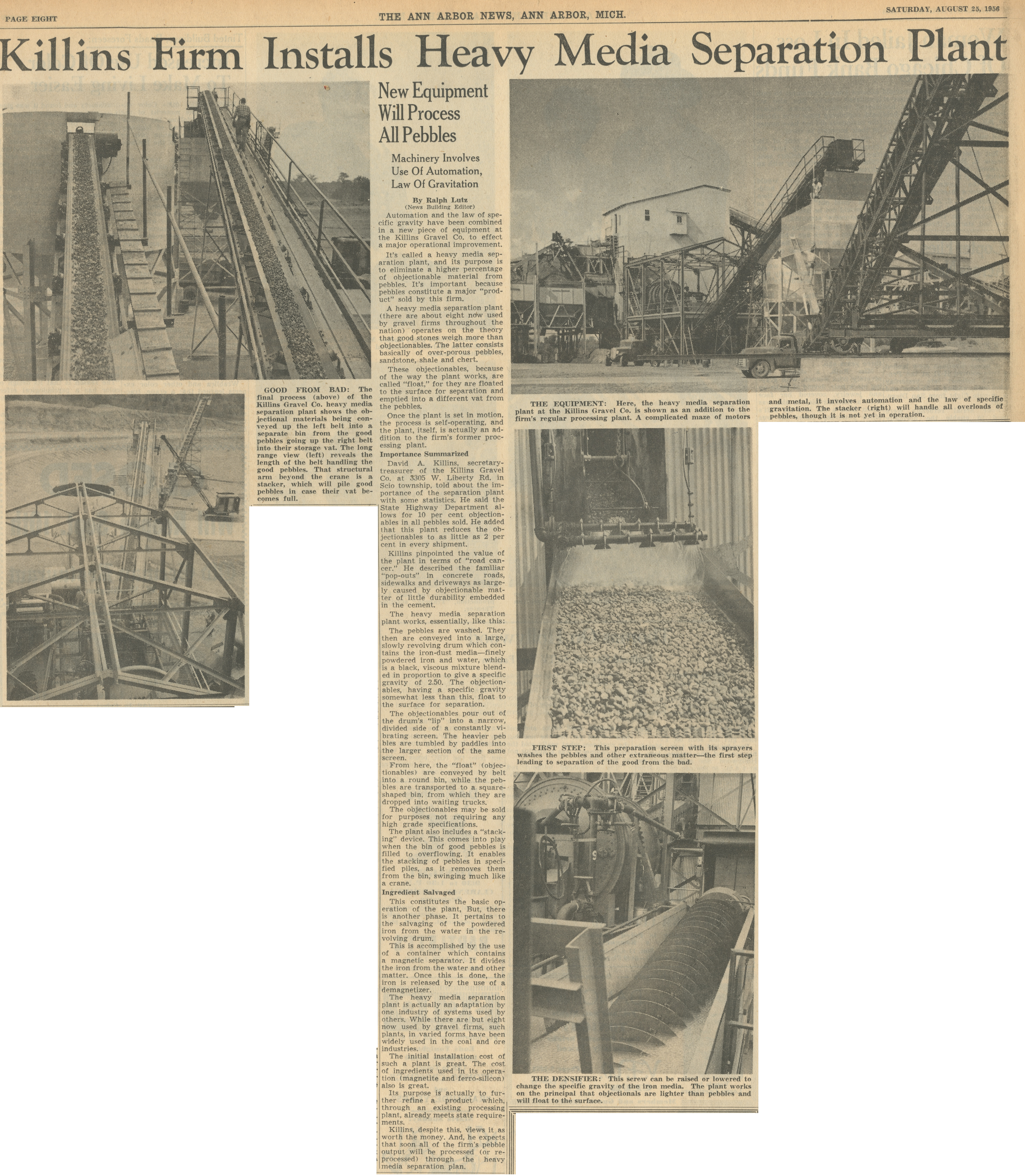Killins Firm Installs Heavy Media Separation Plant

Killins Firm Installs Heavy Media Separation
New Equipment Will Process All Pebbles
Machinery Involves Use Of Automation, Law Of Gravitation
By Ralph Lutz (News Building Editor)
Automation and the law of specific gravity have been combined in a new piece of equipment at the Killins Gravel Co. to effect a major operational improvement.
It's called a heavy media separation plant, and its purpose is to eliminate a higher percentage of objectionable material from pebbles. It’s important because pebbles constitute a major "product” sold by this firm.
A heavy media separation plant (there are about eight now used by gravel firms throughout the nation) operates on the theory that good stones weigh more than objectionables. The latter consists basically of over-porous pebbles, sandstone, shale and chert.
These objectionables, because of the way the plant works, are called “float,” for they are floated to the surface for separation and emptied into a different vat from the pebbles.
Once the plant is set in motion, the process is self-operating, and the plant, itself, is actually an addition to the firm’s former processing plant.
Importance Summarized
David A. Killins, secretary-treasurer of the Killins Gravel Co. at 3305 W. Liberty Rd. in Scio township, told about the importance of the separation plant with some statistics. He said the State Highway Department allows for 10 per cent objectionables in all pebbles sold. He added that this plant reduces the objectionables to as little as 2 per cent in every shipment.
Killins pinpointed the value of the plant in terms of "road cancer.” He described the familiar "pop-outs” in concrete roads, sidewalks and driveways as largely caused by objectionable matter of little durability embedded in the cement.
The heavy media separation plant works, essentially, like this:
The pebbles are washed. They then are conveyed into a large, slowly revolving drum which contains the iron-dust media—finely powdered iron and water, which is a black, viscous mixture blended in proportion to give a specific gravity of 2.50. The objectionables, having a specific gravity somewhat less than this, float to the surface for separation.
The objectionables pour out of the drum’s "lip” into a narrow, divided side of a constantly vibrating screen. The heavier pebbles are tumbled by paddles into the larger section of the same screen.
From here, the "float” (objectionables) are conveyed by belt into a round bin, while the pebbles are transported to a square-shaped bin, from which they are dropped into waiting trucks.
The objectionables may be sold for purposes not requiring any high grade specifications.
The plant also includes a “stacking” device. This comes into play when the bin of good pebbles is filled to overflowing. It enables the stacking of pebbles in specified piles, as it removes them from the bin, swinging much like a crane.
Ingredient Salvaged
This constitutes the basic operation of the plant, but, there is another phase. It pertains lo the salvaging of the powdered iron from the water in the revolving drum.
This is accomplished by the use of a container which contains a magnetic separator. It divides the iron from the water and other matter. Once this is done, the iron is released by the use of a demagnetizer.
The heavy media separation plant is actually an adaptation by one industry of systems used by others. While there are but eight now used by gravel firms, such plants, in varied forms have been widely used in the coal and ore industries.
The initial installation cost of such a plant is great. The cost of ingredients used in its operation (magnetite and ferro-silicon) also is great.
Its purpose is actually to further refine a product which, through an existing processing plant, already meets state requirements.
Killins, despite this, views It as worth the money. And, he expects that soon all of the firm’s pebble output will be processed (or reprocessed) through the heavy media separation plan.
[image]: GOOD FROM BAD: The final process (above) of the Killins Gravel Co. heavy media separation plant shows the objectionable materials being conveyed up the left belt into a separate bin from the good pebbles going up the right belt into their storage vat. The long range view (left) reveals the length of the belt handling the good pebbles. That structural arm beyond the crane is a stacker, which will pile good pebbles in case their vat becomes full.
[image]: THE EQUIPMENT: Here, the heavy media separation plant at the Killins Gravel Co. is shown as an addition to the firm's regular processing plant. A complicated maze of motors and metal, it involves automation and the law of specific gravitation. The stacker (right) will handle all overloads of pebbles, though it is not yet in operation.
[image]: FIRST STEP: This preparations screen with its sprayers washes the pebbles and other extraneous matter-the first step leading to separation of the good from the bad.
[image]: THE DENSIFIER: This screw can be raised or lowered to change the specific gravity of the iron media. The plant works on the principal that objectionables are lighter then pebbles and will float to the surface.